



The tech behind Wolcen – Part 3: Volumetric Fog

Hi everyone!
While we are working on the next update, I wanted to present you a tech we are using a lot!
In the beginning of the development of the game we needed to find some visual particularities to define the look of the game and create a visual identity. One of those, among many others, was the fog. Indeed, with a top down camera, it is quite difficult to have readable “landscape”, as… there is no landscape. But the fog creates the depth of the scene, separates what’s close to what’s far. In the real world, in so short distances (5-40m) almost no fog is visible, so we increased it to have better readable elements on the screen.
Graphics needs to help the gameplay.
And a really nice feature of the engine appears! The volumetric fog. So what’s different compared to the standard fog? Well, it handles better ambient light, sun light and that’s new, take into account the point and projector lights! (and soon, the particle lights).
So how does it makes a difference? See for yourself:
On the technical side, I can’t describe it better than the Crytek’s own explanation :
Voxel-based Volumetric Fog is a new feature that uses volume textures as a view-frustum-shaped voxel buffer to store the incoming light and properties of participating media.
The older Volumetric Fog system can only handle sun with dynamic shadow and exponential height fog density, also in dense fog situations the fog’s appearance is not consistent between opaque and transparent materials.
This new voxel-based Volumetric Fog system can handle sun with dynamic shadow, environment probes, ambient light, and regular light with dynamic shadows, as well as variations in fog density. It also supports the application of Volumetric Fog in a consistent way in respect to opaque and transparent materials.
Voxel-based Volumetric Fog consists of two parts; 1: ray-marching Volumetric Fog and 2: analytical Volumetric Fog.
Ray-marching Volumetric Fog handles all types of light and differing fog densities, while analytical Volumetric Fog handles sun light without dynamic shadow and exponential height fog density.
The area near to the camera is covered by ray-marching Volumetric Fog, while everything else is covered by analytical Volumetric Fog.
(Link at the end of the article)
With that tech, the lighting becomes ever more important, as we can play with the volumes, distances and shapes on a more interesting way. And I’m pretty sure we just scratched the surface yet.
One simple example of it is this one:
During the night, I tried to make sure that the torches are in such distance that you can perceive where the path leads. Being lost in this kind of game is quite annoying.
What about performance? It’s between 0.4ms (low) to 1.0ms (very high). So quite well optimized for a a tech that amazing.
Outside, during day time, the difference is less noticeable, but stills add precision. The ambient and sun light have the right color.
If you want to know more, here is the Crytek’s documentation: http://docs.cryengine.com/display/SDKDOC2/Volumetric+Fog
And is you want to play with it, don’t hesitate, the Cryengine V is free!
I hope you enjoyed this small presentation of this feature and how we use it.
Cheers!
Simon
Replies: 0
Created: 7 years, 5 months ago
Category: Announcements



